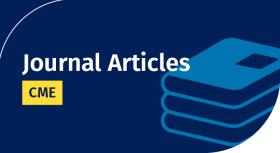
Mask Use with Spacers/Valved Holding Chambers and Metered Dose Inhalers among Children with Asthma
Inhaler misuse is highly prevalent and associated with high morbidity and costs. For metered dose inhalers, proper use can be supported with devices such as spacers/valved holding chambers (VHCs) and masks to effectively deliver inhaled medication to the lungs. However, guidelines are vague about which children with
asthma should use spacers/VHCs with masks to deliver medication from metered dose inhalers as well as when they should transition to spacers/VHCs with mouthpieces. In this paper, we provide a focused review of the evidence for mask use, highlighting unclear and conflicting information in guidelines and studies.
We synthesize the differences in recommendations and practice. Based on these findings, we call for future research to determine the appropriate age and necessary skills for transitioning children from using metered dose inhalers with spacers/VHCs and masks to using spacers/VHCs and mouthpieces. Guidelines about mask use should be standardized to help ensure optimal medical delivery for patients, provide consistent inhaler prescriptions and education across settings, and support team-based care to help lower pediatric asthma morbidity and costs.
Target Audience
Pulmonologists, critical care specialists, translational researchers, and clinicians
Learning Objectives
At the conclusion of this activity, learners should be able to:
- Develop new strategies to improve care and self-management for pediatric patients with asthma who use metered dose inhalers
- Prescribe the most appropriate devices to support the proper use of metered dose inhalers
- Effectively communicate the utility of metered dose inhaler use and either a spacer/valved holding chamber (VHC) with a mask or spacer/VHC with a mouthpiece to patients and their families
Accreditation Statement
The American Thoracic Society is accredited by the Accreditation Council for Continuing Medical Education to provide continuing medical education for physicians.
Disclosure Declaration
Article Authorship Disclosures (as submitted to the ATS prior to article publication date)
Anna Volerman, M.D. (University of Chicago, Chicago, IL, USA) reported receiving grants from CHEST Foundation, University of Chicago Bucksbaum Institute for Clinical Excellence, National Heart, Lung, and Blood Institute, Health Research and Services Administration, Robert Wood Johnson Foundation, and American Thoracic Society Foundation.
Uma Balachandran (University of Chicago, Chicago, IL, USA) reported no relevant financial relationships.
Michelle Siros, B.A. (University of Chicago, Chicago, IL, USA) reported no relevant financial relationships.
Mary Akel, M.P.H. (University of Chicago, Chicago, IL, USA) reported no relevant financial relationships.
Valerie G. Press, M.D., M.P.H. (University of Chicago, Chicago, IL, USA) reported receiving grants from National Heart, Lung, and Blood Institute and American Lung Association; consults for Humana and Vizient; and has consulted for Roundglass within the past three years
Off-Label Usage Disclosure
None
Disclosures of AnnalsATS CME Planners
The Annals of the American Thoracic Society (AnnalsATS) original research, commentaries, reviews, and educational content of interest to clinicians and clinical investigators in pediatric and adult pulmonary and sleep medicine and medical critical care. The scope of the journal encompasses content that is applicable to clinical practice, the formative and continuing education of clinical specialists, and the advancement of public health.
The publication of articles that meet these goals by itself is only one step in a multi-step process for the translation of evidence-based improvements in are to clinical practice. Testing for CME credit is designed to function as a next step in the process. This is accomplished through a series of questions written by the author(s) to test that readers have the tools needed to translate recommendations for diagnostic and therapeutic clinical care into clinical practice. Members of the AnnalsATS editorial board review these questions and edit these questions for clarity, educational content, and the quality of the evidence supporting the response to the question.
AnnalsATS CME Planners
Alan M. Fein, M.D.
Podcast Editor, AnnalsATS
Dr. Fein reported that he has no financial relationships with ineligible companies.
Constantine Manthous, M.D.
Associate Editor, AnnalsATS
Dr. Manthous reported that he has no financial relationships with ineligible companies.
Gregory A. Schmidt, M.D.
Editorial Board, AnnalsATS
Dr. Schmidt reported payments for writing a textbook on critical care medicine (McGraw-Hill) and for writing contributions for UptoDate.
Instructions to Receive Credit
To receive credit for this journal article:
- Read the journal article. Keep track of how long it takes you to read it.
- Once you open the article, the Post-Test becomes available. After reading the article, answer the post-test questions. You must answer all questions correctly to earn credit. You may take the test as many times as you like.
- Once you pass the Post-Test, the Evaluation becomes available. Answer all the evaluation questions.
- Once you complete the evaluation, select the amount of credit to receive based on the time it took you to read the article.
- You can view, save and print your Certificate by pressing the Certificate button.
- To review the credits you've earned in this system and reprint certificates, go to the My Learning drop-down list. Then select Transcript.
Available Credit
- 1.00 AMA PRA Category 1 Credit(s)™The American Thoracic Society designates this for a maximum of 1.00 AMA PRA Category 1 Credit(s)™. Physicians should claim only the credit commensurate with the extent of their participation in the activity.
- 1.00 Participation

 Facebook
Facebook X
X LinkedIn
LinkedIn Forward
Forward